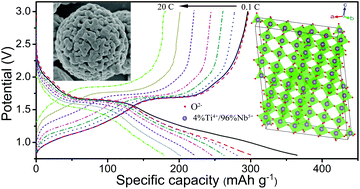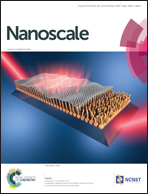Porous TiNb24O62 microspheres as high-performance anode materials for lithium-ion batteries of electric vehicles†
Abstract
TiNb24O62 is explored as a new anode material for lithium-ion batteries. Microsized TiNb24O62 particles (M-TiNb24O62) are fabricated through a simple solid-state reaction method and porous TiNb24O62 microspheres (P-TiNb24O62) are synthesized through a facile solvothermal method for the first time. TiNb24O62 exhibits a Wadsley–Roth shear structure with a structural unit composed of a 3 × 4 octahedron-block and a 0.5 tetrahedron at the block-corner. P-TiNb24O62 with an average sphere size of ∼2 μm is constructed by nanoparticles with an average size of ∼100 nm, forming inter-particle pores with a size of ∼8 nm and inter-sphere pores with a size of ∼55 nm. Such desirable porous microspheres are an ideal architecture for enhancing the electrochemical performances by shortening the transport distance of electrons/Li+-ions and increasing the reaction area. Consequently, P-TiNb24O62 presents outstanding electrochemical performances in terms of specific capacity, rate capability and cyclic stability. The reversible capacities of P-TiNb24O62 are, respectively, as large as 296, 277, 261, 245, 222, 202 and 181 mA h g−1 at 0.1, 0.5, 1, 2, 5, 10 and 20 C, which are obviously larger than those of M-TiNb24O62 (258, 226, 210, 191, 166, 147 and 121 mA h g−1). At 10 C, the capacity of P-TiNb24O62 still remains at 183 mA h g−1 over 500 cycles with a decay of only 0.02% per cycle, whereas the corresponding values of M-TiNb24O62 are 119 mA h g−1 and 0.04%. These impressive results indicate that P-TiNb24O62 can be a promising anode material for lithium-ion batteries of electric vehicles.



 Please wait while we load your content...
Please wait while we load your content...